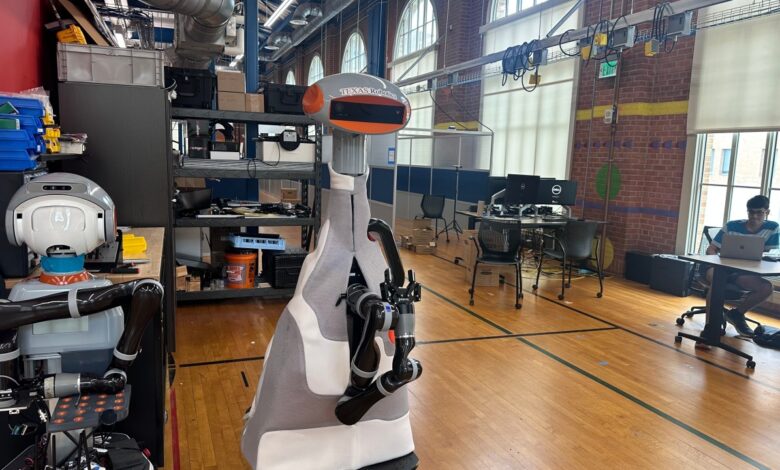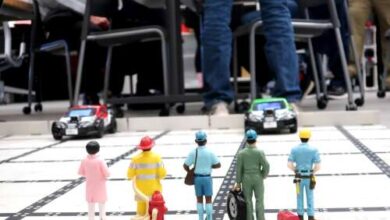From Gym Floors to Smart Robots

AUSTIN (KXAN) — Robots are getting in their reps at the University of Texas. Within the Anna Hiss Gymnasium, the team at Texas Robotics, a group of UT researchers and students, is using artificial intelligence to train and control the next wave of robots.
“One of the tasks is for the robot to be able to take the bowl and put it on the table and pour some cereal into the bowl,” said Professor Peter Stone while watching one robot work its way through a mock apartment. Its wheels rolling over an old gym floor, while in the distance a four-legged robot bounded its way through an old basketball court.
The space was converted into the the university’s robotics lab in 2020. Much of the old structure has been retained like the shuffle board outlines in the concrete hallways and the painted lines along the court.
Now, instead of training athletes, it is helping train the next generation of robots and artificial intelligence.
What is Artificial Intelligence?
Professor Stone’s work is being featured as part of a new University of Texas podcast: “AI for the Rest Us.” On the first episode, released on June 6, Prof. Stone, alongside hosts Marc Airhart and Casey Boyle, explores the big question of “What is AI?”
“The goal is to exhibit intelligent behaviors, whether or not it’s doing it the same way that people do it,” said Prof. Stone about AI. This is the modern definition of AI, but it is a moving target.
“Things like, you know, being able to press a button on your microwave oven and say, ‘I want to heat up a potato,’ and it knows your senses. How long should the microwave stay on? That was once considered artificial intelligence.”
A lot of the problem comes down to deciding what we mean by intelligence. Is it creating unique thoughts or mimicry to the point where it’s indistinguishable from intelligence?
“Can we build artifacts that do intelligent things, regardless of how they do it, in the same way that you know, airplanes fly, but not the same way that birds do?” Prof. Stone said.
AI, according to Professor Stone, comes in a few varieties. Things like Chat GPT are generative AI. These forms of AI are trained by being fed information from across the internet. This form of AI is disembodied intelligence, it exists in a cloud or on a server.
“The definition of of artificial intelligence sort of shifts over time”
Professor Peter Stone | Director of Texas Robotics
Another form of AI is trained through experiences. Stone compares this to placing a child in a playpen and allowing them to learn through interaction.
“One of the sort of tongue in cheek ways of defining artificial intelligence is that it’s the practice of trying to get computers to do the things they can’t do yet,” said Prof. Stone.
The rapid evolution of AI
Artificial intelligence has exploded in the last few years as a result of things like Chat GPT and the expansion of robotics. Today, little bots can bring you Chick-Fil-A and deliver your groceries. This is all thanks to AI. Without it, these robots would have a hard time navigating our world.
“Robots, in some sense, are embodied intelligence or embodied artificial intelligence and, and we’re striving to get them to be as robust and general purpose in the physical realm,” Prof. Stone said.

This rapid evolution has surprised even experts in the field.
“It’s such early days in artificial intelligence. And so few companies have done anything meaningful with it, that it’s actually pretty astounding how much opportunity there is,” said Ron Green, cofounder and CTO of KUNGFU.AI.
The Austin-based company helps businesses take advantage of AI. Green said that businesses can use AI to help reduce fraud, optimize trades on the stock market and reduce costs through automation.
“Where we find you have the biggest impact is when you can use it to augment humans; don’t use it to replace humans, use it to make them more powerful or more capable,” Green said.
AI is already outpacing humans in many fields. “You can have AI systems that can understand hundreds of languages and say that back to you in any other of those hundreds of hundreds of languages.”
Green suspects that within the next 12-24 months, AI will reach new levels in the home. Things like Siri and Alexa will be able to respond to more complex, randomly assembled sentences, as opposed to now where they need short precise phrases.
“AI is moving rapidly. It’s not an exaggeration to say it’s moving so quickly, that it’s somewhat caught all of us off guard.”
RON GREEN | COFOUNDER & CTO at KUNGFU.AI
Green also suspects within our lifetime we could see super intelligent AI that will completely outpace humans.
Should you be afraid of AI?
Yes and no. Professor Stone compares AI to cars. “Cars, they were introduced to the masses in the early 1900s. And they’re not all good, right? There’s emissions, they’re causing pollution, there are 40,000 fatal accidents a year on our roadways.”
However, cars also provide numerous benefits and have reshaped the world. “Artificial Intelligence is no different. There’s, there are some risks, there’s things that may go wrong,” Prof. Stone said. “On the other hand, the beneficial possibilities are enormous.”
“We should be thoughtful and deliberate about this. I don’t know if we should be concerned. But these systems are going to become very powerful,” Green said.

Green thinks one thing we should watch out for is “alignment.” Because AI grows using data from our history, it also carries with it our past misdeeds and prejudices.
“You can imagine a situation where somebody is denied a loan. For reasons that are not ethical. And somebody might point to that AI system said, ‘Well, you know, it’s completely unbiased, it made the decision.’ That’s actually not the case. It is biased,” Green said.
“So AI is just another one of these technologies, where there’s risks and benefits and, and we need to try to craft policy, which is sort of a big focus of governments right now. That will maximize the chances that we can realize the benefits and don’t get sort of caught up in the risks,” said Prof. Stone.
The world at large will need to decide: do we sit around and ignore the possibilities or should we do what our robot friends are doing and hit the gym?
It may be the only way to get in the proper shape for the future.



